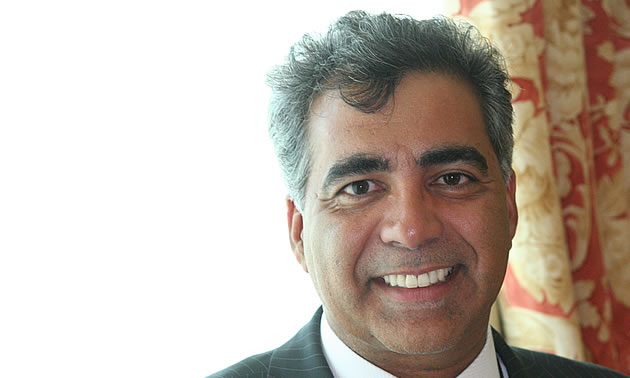Fission Energy
17 years ago, an investment banker changed career tracks and he hasn’t looked back

Dev Randhawa, CEO of Fission Energy, builds a career with longevity. — Photo courtesy Fission Energy
Dev Randhawa started a career as an investment banker, but nobody expected that he would become the CEO of a junior mining company.
“I got frustrated and I actually wanted to run something,” said Randhawa. “Investment banking is like a beauty contest. Every day you’ve got to pitch to people and raise money, but when you run your own company, you have a long-term view and I think it’s more satisfying.”
After 26 years in the mining industry, Randhawa has a career with longevity and he predicts that the uranium market is worth watching.
“To build a store for uranium, you really have to build a store for energy,” said Randhawa. “If there isn’t going to be a great growth in energy, you won’t see a great demand for uranium because it’s all part of the same mix.”
Randhawa said that Fission Energy tends to be aggressive when the markets are bad. Fission looks for companies with good resources whose management has been unable to raise funds to develop their asset while the cost of uranium resources has decreased on the market. Randhawa recalls buying property for $100,000 at a point while the markets were down, and selling the same property for $15 million when the market improved.
According to Randhawa, 17 per cent of the world's production of uranium comes from within a specific area in Saskatchewan, the Athabasca Basin. The grade of uranium in this particular area is allegedly 10 to 20 times the world’s average.
“I’m happy to see Saskatchewan growing and thriving,” said Randhawa.
Fission Energy's Corporate Timeline & Exploration Highlights
July 2007 – Fission Energy Corp. is created via a spinoff from Strathmore Minerals taking over all Canadian and Peruvian assets.
Jan. 2008 – Fission Energy and ESO Uranium form Patterson Lake South Joint Venture.
Jan. 2008 – Fission Energy closes an earn-in agreement with Korean Waterbury Consortium for Waterbury Lake; Korean Waterbury Consortium to spend $14 million in exploration over three years to earn 50% of Waterbury Lake project.
Feb. 2010 – High-grade uranium discovered at Waterbury Lake. Fission discovery hole WAT10-063A assays at 10.5m of 1.91% U3O8 including 1.0m grading 13.87% U3O8; hole WAT10-063A intersects 12m of 3.64% U3O8 including mineralization as high as 45.2% U3O8.
March 2010 – Drill hole WAT10-072C (A 10m vertical step-out from hole WAT10-070B) intersects 6m of 14% U308 at conformity, including 4m grading21.2% U3O8.
March 2010 – Fission hits off-scale radioactivity on three more vertical step-out holes (WAT10-081, 085 and 087) to extend J Zone to 40x80m.
March 2010 – Step-outs WAT10-092A and 094A intersect highly radioactive mineralization 140m west and 70m east of the J Zone (Highland and J East).
Aug 2010 – Fission and KEPCO Consortium enter into a definitive limited partnership agreement for the joint exploration and development of Waterbury Lake; expenditures to double to $30 million over three years.
Sept. 2010 – J Zone vertical step-out WAT10-098A intersects 12m of 5.95% U3O8 at unconformity, including 6m grading 11.71% U3O8. Summer drill program expands J Zone to ~120m x 50m.
Feb. 2011 – Fission Energy named one of TSX Venture Exchange’s top 50 companies.
Feb. 2011 – Fission hits new mineralization at the unconformity 338m west of the J Zone WAT11-122 (later named PKB Zone).
March 2011 – Fission discovers new mineralization near the unconformity, WAT11-153A, 1.3km west of the J Zone (later named Summit Zone).
March 2011 – Hole WAT11-131 intersects 14.5m of 7.84% U3O8 on 60m step-out from drill hole WAT10-103.
April 2011 – Fission Energy exercises its back-in option to acquire an additional 10% interest in the limited partnership exploring the Waterbury Lake project (Fission 60%; KEPCO Consortium 40%).
April 2011 – Fission winter drill program successfully expands J Zone to ~370m; five mineralized discoveries are now targeted within Discovery Bay corridor.
June 2011 – Fission discovers uranium boulder field with off-scale radioactivity at Patterson Lake South Property. Boulder assays up to 39.6% U3O8.
Aug. 2011 – Fission expands J Zone strike length to 578m or by 56% since drilling resumed in July.
Jan. 2012 – Fission Energy announces preliminary NI 43-101 resource estimate at J Zone uranium deposit; 7,367,000 lbs indicated based on 168,000 tonnes at an average grade of 1.99% U3O8; an additional 1,511,000 lbs. inferred based on 150,000 tonnes averaging 0.46% U3O8.
Feb 2012 – Three step-out holes, WAT12-237B, 242 and 244 intersect off-scale radioactivity expanding central J Zone.
Feb 2012 – Drill rig mobilized at Patterson Lake South to locate the bedrock source area of the high grade uranium boulder field discovery.
For more information on Fission Energy, visit the website.




